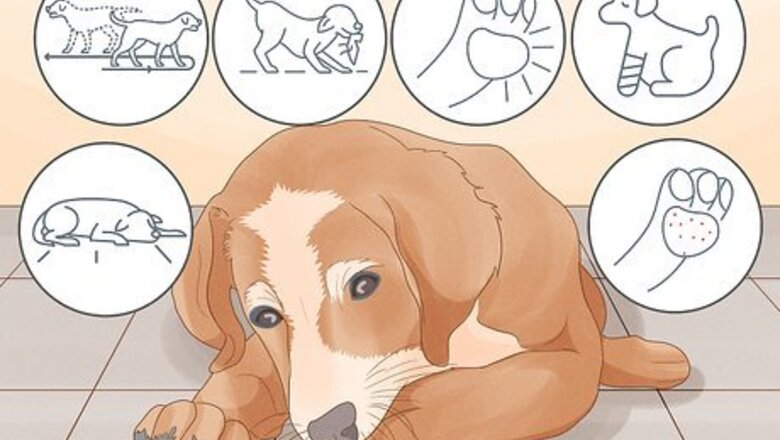
views
Start by figuring out why your dog is chewing its paws.
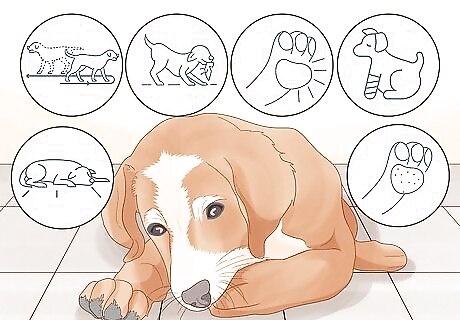
Examine your pup's paws and behavior to find underlying issues. The cause of your pup's licking will help you learn what it needs. Is your dog asking for a little extra attention? Is it itching? Is it simply hungry? Look for these signs: Boredom: Repeating behavior when alone with no other noticeable trigger. Anxiety: No physical signs, but shows behavioral signs. Allergies: Excessive chewing after coming in contact with something repeatedly. Infection: Inflamed or swollen paw pads. Injury: Scrapes or cuts on paw pads. Parasites: Red, thickened skin or tiny red dots on paw pads. Take your furry friend to the vet if they have a wound, inflamed or discolored skin, or other abnormal symptoms—it’s always better to be safe than sorry!
Give your dog a chew toy.
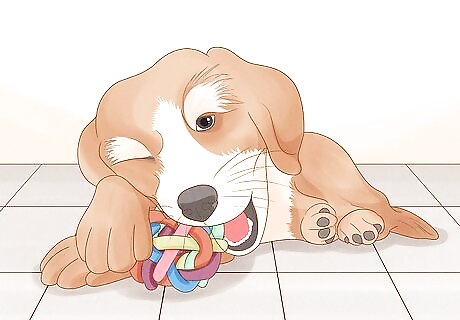
This is a great way to redirect your dog's chewing. You can distract your pup with a fun new toy rather than trying to catch it in the chewing act. Not only is this an easy way to redirect your pup's chewing, but it also helps keeps it occupied and entertained—a win-win! Follow these tips to find the perfect chew toy for your pup: Look for toys that are designed for chewing and little supervision. Make sure the toy is soft enough to indent with a fingernail. Pick a toy that's bigger than your pup's throat. Double check the label to see if the toy is safe if swallowed.
Toss your dog a chew treat.
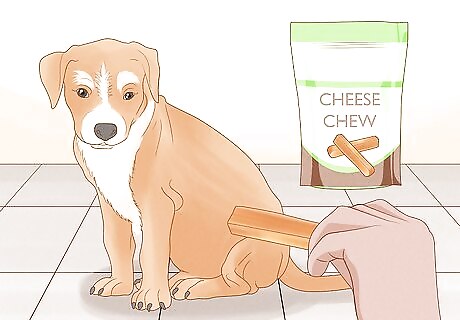
Chewing could be a sign of boredom or hunger. You can combat both of these causes by giving your furry friend an edible bone or dental treat to gnaw on. These two snacks will help tide your dog over until the next meal and keep it occupied. Here are some tips for picking out the best chew treat for your dog: Pick a chew that your pup can’t fit in its mouth at once to avoid choking hazards. Choose a chew that can handle vigorous gnawing that’s not too soft. Avoid chews with flavorings or coatings that may upset your pup's tummy. Check the label for trusted ingredients as not all bones are digestible. Bully sticks, yak cheese chews, tendon chews, and trachea are great chew treats with minimal risks.
Keep your dog busy with a deconstruction box.

If your pup's bored, it may be chewing because it has nothing else to do. Tossing a box full of interesting, destroyable things its way is a great way to liven up any afternoon! Your pup will have to use its curious brain and chomping teeth to find the hidden treats. Make this DIY interactive toy yourself with a cardboard box, scrap paper, and treats by following these easy steps: Shred a stack of paper into strips and crumble another stack into paper balls. Put a few of your pup's favorite treats in the box. Fill the box with paper strips, paper balls, and toys, burrowing the treats. Keep a watchful eye on your pup while it plays so it doesn’t swallow pieces of paper or cardboard.
Feed your dog using a puzzle feeder.
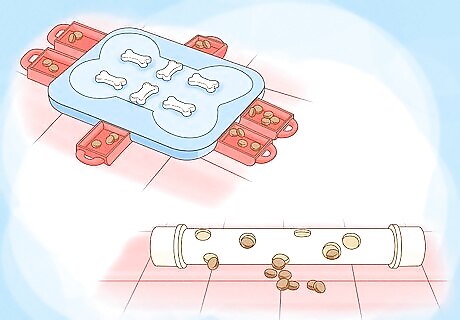
Stimulation can be a great distraction for an intelligent pup. Puzzle feeders are a great way to keep your dog occupied, entertained, and happy. These interactive food bowls help keep your dog busy—with food and a puzzle—so it'll be less likely to chew its paws out of boredom. Find puzzle feeders at your local pet store, online, or you can even make your own. Filling a conduit or PVC pipe with treats or kibble is a creative and cheap way to DIY your own interactive feeder.
Play with your dog.
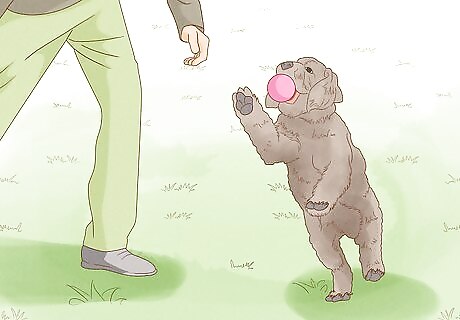
Your pup may be chewing just to amuse itself. Your furry friend will do anything to keep itself occupied if it's bored—even chewing on its own paws! Take time out of your schedule to play with your very best friend each and every day. Maybe that means a game of fetch after lunch, tug-of-war before bed, or a good race around the house during work breaks. This is especially important if you have a puppy. It's not trying to hurt itself—it just wants to have a bit of fun!
Soothe your dog if it's anxious or stressed.
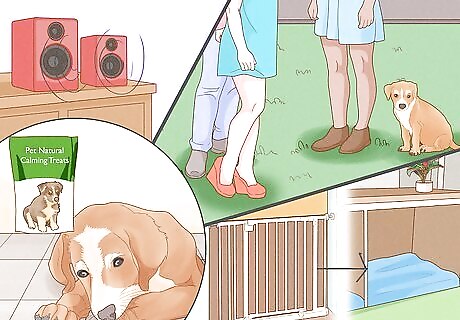
Reducing triggers can do wonders for stopping a chewing habit. On top of biting its paws, notice if your pup is excessively growling, whining, tucking its tail between its legs, or pacing. Take note of what's happening around your pup when it does this behavior, and do your best to eliminate the anxiety source. This will help your pup calm down and stop chewing its paws. For example, some dogs may be stressed out by loud noises, new people, or a change in environment. Chewing may be a nervous or anxious tick, and removing as many triggers as possible from your furry friend's routine can help it be happier and healthier. You can also try calming treats to help relieve anxiety. Talk to your veterinarian about your dog's behavior. They can help you pinpoint and diagnose stress and anxiety.
Rinse your dog's paws if something is irritating them.
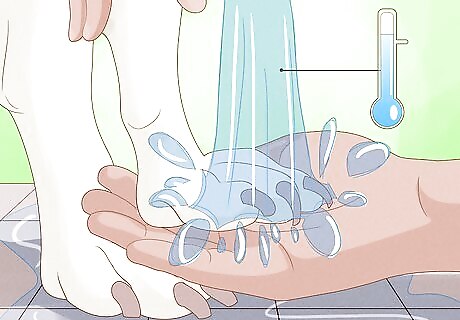
Wash allergens away to keep your pup's paws happy and healthy. If you notice your pup gnawing at its paws the second it comes inside after a nice run or roll around in the grass, your pup may be allergic to something outside. Give those paws a thorough rinse with cool, clean water to help combat the itch and keep your dog from chewing. The same applies to indoor areas. Suppose your pup starts chewing on its paws after laying on a carpet, blanket, or furniture. In that case, it might be allergic to a detergent or cleaner. Contact your veterinarian if you think your dog has an allergy. They’ll be able to give you advice on how to treat your dog's particular allergy.
Apply a paw balm if your dog's paws are irritated.
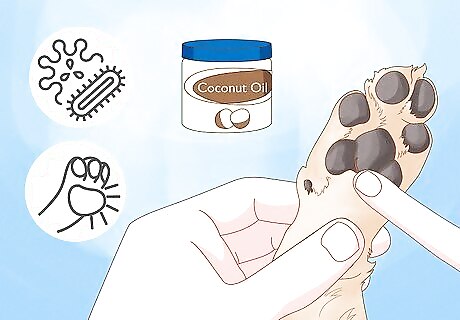
Stop your dog from chewing its paws by easing itch and irritation. If your pup has an infection, inflamed paw pads, or even a cut or scrape, it’s most likely chewing in an attempt to fix the problem. You can help your furry friend by applying a soothing or medical balm to its paws—just make sure the balm you use doesn't have any toxic ingredients in case they start nibbling again. Go for balms made of natural ingredients like coconut oil, sunflower oil, and cocoa butter. If your pup has an infection, talk to your veterinarian about the best topical treatments.
Invest in a pair of dog booties.
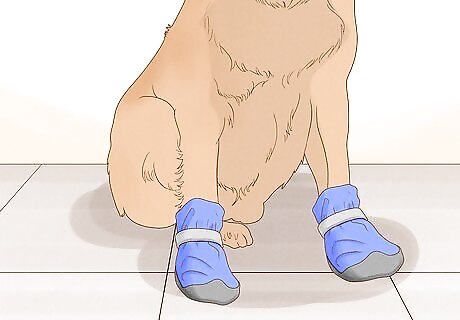
These stylish shoes will keep your pup from chewing its paws. Dog booties are typically used in the winter or summer to protect a dog's paws from harsh weather conditions, but who says they can't be used whenever? The booties work as a protective layer between your pup’s teeth and paws, keeping your pup from tearing at its skin and preventing future infections. If you can't buy a pair of booties right away, no problem! Socks are a great alternative option. Simply put a pair of socks on your pup's front legs, bandaging them at the top if they fall down.
Try putting an E-collar on your dog.
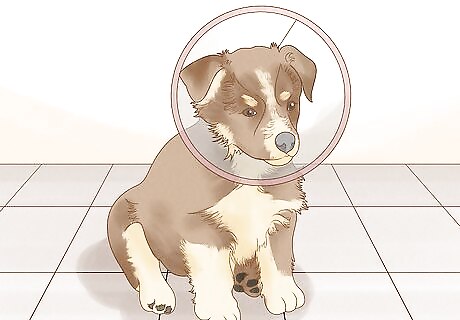
If your pup has an infection, keep it away from its paws. An E-collar is a collar with a large dish that wraps around your pup's neck. Vets typically use this collar for dogs recovering from surgery to keep them from licking stitches—and it can work the same way to stop your dog from chewing its paws. Simply keep the collar on until the infection has healed, or for as long as your veterinarian recommends. You may know the E-collar by its more popular term, "the cone of shame." When choosing an E-collar, always pick one that's longer than your pup's nose. This means that the end of the cone should go past the snout. Soft E-collars are also an option. They're a short, inflatable ring you can place around your pup's neck that's not as big and a bit more comfortable.

















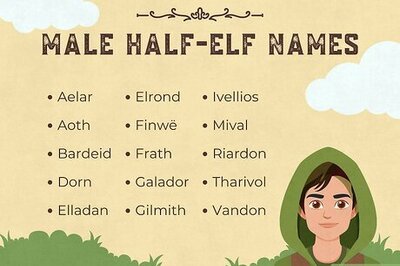
Comments
0 comment